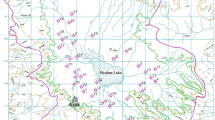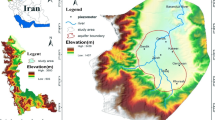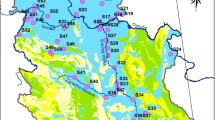Abstract
The present study attempts to model the spatial variability of three groundwater qualitative parameters in Guilan Province, northern Iran, using artificial neural networks (ANNs) and support vector machines (SVMs). Data collected from 140 observation wells for the years 2002–2014 were used. Five variables, X and Y coordinates of the observation well, distance of the observation well from the shoreline, areal average 6-month rainfall depth, and groundwater level at the day of water quality sampling, were considered as primary input variables. In addition, nine qualitative variables were also considered as auxiliary input variables. Electrical conductivity (EC), sodium concentration (Na+), and sulfate concentration (SO4 2−) of the groundwater in the region were estimated using ANNs and SVMs with different input combinations. The results showed that both ANNs and SVMs work well when the only primary input variable is the well location. The ANN yielded an RMSE of 1.03 mEq/l for SO4 2−, 1.05 mEq/l for Na+, and 203.17 μS/cm for EC, using the X and Y coordinates of the observation wells in the study area. In the case of SVM, these values were, respectively, 0.87, 0.87, and 176.68. Considering the auxiliary input variables (pH, EC, and the concentrations of Na+, K+, Ca2+, Mg2+, Cl−, SO4 2−, and HCO3 −) resulted in a significant decrease in the RMSE of both ANNs (0.22, 0.30, and 33.04) and SVMs (0.26, 0.34, and 36.23). Comparing these RMSE values with those of cokriging interpolation technique (0.59, 0.98, and 177.59) indicated that ANNs and SVMs produced more accurate estimates of the three qualitative parameters. The relative importance of auxiliary input variables was also determined using Gamma test. The output uncertainty of ANNs and SVMs were determined using p-factor and d-factor. The results showed that SVMs have less uncertainty than ANNs.
Similar content being viewed by others
References
Abbaspour KC, Yang J, Maximov I, Siber R, Bogner K, Mieleitner J, Zobrist J, Srinivasan R (2007) Modelling hydrology and water quality in the pre-alpine/alpine Thur watershed using SWAT. J Hydrol 333:413–430. doi:10.1016/j.jhydrol.2006.09.014
Adamowski J, Chan HF (2011) A wavelet neural network conjunction model for groundwater level forecasting. J Hydrol 407:28–40. doi:10.1016/j.jhydrol.2011.06.013
Adamowski J, Fung Chan H, Prasher SO, Ozga-Zielinski B, Sliusarieva A (2012) Comparison of multiple linear and nonlinear regression, autoregressive integrated moving average, artificial neural network, and wavelet artificial neural network methods for urban water demand forecasting in Montreal, Canada. Water Resour Res 48:1–15. doi:10.1029/2010WR009945
Arabgol R, Sartaj M, Asghari K (2015) Predicting nitrate concentration and its spatial distribution in groundwater resources using support vector machines (SVMs) model. Environ Model Assess 21:71–82. doi:10.1007/s10666-015-9468-0
ASCE Task Committee on Application of Artificial neural Networks in Hydrology (2000) Artificial neural networks in hydrology. I: preliminary concepts. J Hydrol Eng 5:115–123. doi:10.1061/(ASCE)1084-0699(2000)5:2(115)
Ashrafzadeh A, Roshandel F, Khaledian M, Vazifedoust M, Rezaei M (2016) Assessment of groundwater salinity risk using kriging methods: a case study in northern Iran. Agric Water Manag 178:215–224. doi:10.1016/j.agwat.2016.09.028
Baghvand A, Nasrabadi T, Bidhendi GN, Vosoogh A, Karbassi A, Mehrdadi N (2010) Groundwater quality degradation of an aquifer in Iran central desert. Desalination 260:264–275. doi:10.1016/j.desal.2010.02.038
Chang FJ, Chiang YM, Tsai MJ, Shieh MC, Hsu KL, Sorooshian S (2014) Watershed rainfall forecasting using neuro-fuzzy networks with the assimilation of multi-sensor information. J Hydrol 508:374–384. doi:10.1016/j.jhydrol.2013.11.011
Chen ST, Yu PS, Liu BW (2011) Comparison of neural network architectures and inputs for radar rainfall adjustment for typhoon events. J Hydrol 405:150–160. doi:10.1016/j.jhydrol.2011.05.017
Chiang YM, Chang FJ, Jou BJD, Lin PF (2007) Dynamic ANN for precipitation estimation and forecasting from radar observations. J Hydrol 334:250–261. doi:10.1016/j.jhydrol.2006.10.021
Chowdhury M, Alouani A, Hossain F (2010) Comparison of ordinary kriging and artificial neural network for spatial mapping of arsenic contamination of groundwater. Stoch Environ Res Risk Assess 24:1. doi:10.1007/s00477-008-0296-5
Dibike YB, Velickov S, Solomatine D, Abbott MB (2001) Model induction with support vector machines: introductoin and applications. J Comput Civil Eng 15:208–216. doi:10.1061/(ASCE)0887-3801(2001)15:3(208)
Fausett L (1994) Fundamentals of neural networks: architectures, algorithms and applications. Prentice Hall, Englewood Cliffs
Ghorbani MA, Zadeh HA, Isazadeh M, Terzi O (2016) A comparative study of artificial neural network (MLP, RBF) and support vector machine models for river flow prediction. Environ Earth Sci 75:1–14. doi:10.1007/s12665-015-5096-x
GRWA (Guilan Regional Water Authority) (2016) http://www.glrw.ir/
Hagan MT, Menhaj MB (1994) Training feedforward networks with the marquardt algorithm. IEEE Trans Neural Netw 5:989–993. doi:10.1109/72.329697
Hornik K, Stinchcombe M, White H (1989) Multilayer feedforward networks are universal approximators. Neural Netw 2:359–366. doi:10.1016/0893-6080(89)90020-8
Hsu K, Gao X, Sorooshian S, Gupta HV (1997) Precipitation estimation from remotely sensed information using artificial neural networks. J Appl Meteorol 36:1176–1190. doi:10.1175/1520-0450(1997)036<1176:PEFRSI>2.0.CO;2
IWRMC (Iran Water Resources Management Co.) (2016) http://www.wrm.ir/
Kashani MH, Ghorbani MA, Dinpashoh Y, Shahmorad S (2016) Integration of Volterra model with artificial neural networks for rainfall-runoff simulation in forested catchment of northern Iran. J Hydrol 540:340–354. doi:10.1016/j.jhydrol.2016.06.028
Kasiviswanathan KS, He J, Sudheer KP, Tay JH (2016) Potential application of wavelet neural network ensemble to forecast streamflow for flood management. J Hydrol 536:161–173. doi:10.1016/j.jhydrol.2016.02.044
Khalil A, Almasri MN, McKee M, Kaluarachchi JJ (2005) Applicability of statistical learning algorithms in groundwater quality modeling. Water Resour Res 41:1–16. doi:10.1029/2004WR003608
Krishna B, Satyaji Rao YR, Rao Vijaya T (2008) Modelling groundwater levels in an urban coastal aquifer using artificial neural networks. Hydrol Process 22:1180–1188. doi:10.1002/hyp.6686
Lin GF, Chen GR, Huang PY, Chou YC (2009) Support vector machine-based models for hourly reservoir inflow forecasting during typhoon-warning periods. J Hydrol 372:17–29. doi:10.1016/j.jhydrol.2009.03.032
Liu H, Chandrasekar V, Xu G (2001) An adaptive neural network scheme for radar rainfall estimation from WSR-88D observations. J Appl Meteorol 40:2038–2050. doi:10.1175/1520-0450(2001)040<2038:AANNSF>2.0.CO;2
Modaresi F, Araghinejad S (2014) A comparative assessment of support vector machines, probabilistic neural networks, and K-nearest neighbor algorithms for water quality classification. Water Resour Manag 28:4095–4111. doi:10.1007/s11269-014-0730-z
Moradkhani H, Hsu K, Gupta HV, Sorooshian S (2004) Improved streamflow forecasting using self-organizing radial basis function artificial neural networks. J Hydrol 295:246–262. doi:10.1016/j.jhydrol.2004.03.027
Msiza IS, Nelwamondo FV, Marwala T (2008) Water demand prediction using artificial neural networks and support vector regression. J Comput 3:1–8
Noori R, Hoshyaripour G, Ashrafi K, Araabi BN (2010) Uncertainty analysis of developed ANN and ANFIS models in prediction of carbon monoxide daily concentration. Atmos Environ 44:476–482. doi:10.1016/j.atmosenv.2009.11.005
Noori R, Karbassi AR, Moghaddamnia A, Han D, Zokaei-Ashtiani MH, Farokhnia A, Gousheh MG (2011) Assessment of input variables determination on the SVM model performance using PCA, Gamma test, and forward selection techniques for monthly stream flow prediction. J Hydrol 401:177–189. doi:10.1016/j.jhydrol.2011.02.021
Nourani V (2017) An Emotional ANN (EANN) approach to modeling rainfall-runoff process. J Hydrol 544:267–277. doi:10.1016/j.jhydrol.2016.11.033
Nourani V, Alami MT, Vousoughi FD (2016) Self-organizing map clustering technique for ANN-based spatiotemporal modeling of groundwater quality parameters. J Hydroinform 18:288–309. doi:10.2166/hydro.2015.143
Razin MRG, Voosoghi B, Mohammadzadeh A (2016) Efficiency of artificial neural networks in map of total electron content over Iran. Acta Geod Geophys 51:541. doi:10.1007/s40328-015-0143-3
Shoaib M, Shamseldin AY, Melville BW (2014) Comparative study of different wavelet based neural network models for rainfall-runoff modeling. J Hydrol 515:47–58. doi:10.1016/j.jhydrol.2014.04.055
Suykens JAK, Van Gestel T, De Brabanter J, De Moor B, Vandewalle J (2002) Least squares support vector machines. World Scientific, Singapore
Taheri Tizro A, Voudouris KS (2008) Groundwater quality in the semi-arid region of the Chahardouly basin, West Iran. Hydrol Process 22:3066–3078. doi:10.1002/hyp.6893
Vapnik V, Golowich SE, Smola A (1996) Support vector method for function approximation, regression estimation, and signal processing. In: Annual conference on neural information processing systems, pp 281–287. doi:10.1007/978-3-642-33311-8_5
Wang WC, Chau KW, Cheng CT, Qiu L (2009) A comparison of performance of several artificial intelligence methods for forecasting monthly discharge time series. J Hydrol 374:294–306. doi:10.1016/j.jhydrol.2009.06.019
Wu CL, Chau KW (2011) Rainfall-runoff modeling using artificial neural network coupled with singular spectrum analysis. J Hydrol 399:394–409. doi:10.1016/j.jhydrol.2011.01.017
WWCGP (Water and Wastewater Company of Guilan Province) (2016) http://www.abfa-guilan.ir/
Yang J, Reichert P, Abbaspour KC, Xia J, Yang H (2008) Comparing uncertainty analysis techniques for a SWAT application to the Chaohe Basin in China. J Hydrol 358:1–23. doi:10.1016/j.jhydrol.2008.05.012
Yoon H, Jun SC, Hyun Y, Bae GO, Lee KK (2011) A refcomparative study of artificial neural networks and support vector machines for predicting groundwater levels in a coastal aquifer. J Hydrol 396:128–138. doi:10.1016/j.jhydrol.2010.11.002
Zheng Z, Zhang F, Chai X, Zhu Z, Ma F (2009) Spatial estimation of soil moisture and salinity with neural kriging. In: Li D, Chunjiang Z (eds), IFIP International Federation for Information Processing, volume 294, Computer and computing technologies in agriculture II, volume 2, Boston
Author information
Authors and Affiliations
Corresponding author
Rights and permissions
About this article
Cite this article
Isazadeh, M., Biazar, S.M. & Ashrafzadeh, A. Support vector machines and feed-forward neural networks for spatial modeling of groundwater qualitative parameters. Environ Earth Sci 76, 610 (2017). https://doi.org/10.1007/s12665-017-6938-5
Received:
Accepted:
Published:
DOI: https://doi.org/10.1007/s12665-017-6938-5










